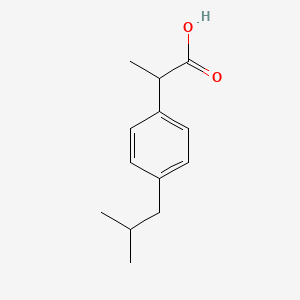m6A-centered Drug Response Information
General Information of the Drug (ID: M6APDG01454)
| Name |
Ibuprofen
|
||||
|---|---|---|---|---|---|
| Synonyms |
ibuprofen; 15687-27-1; 2-(4-Isobutylphenyl)propanoic acid; Motrin; Brufen; Advil; Nurofen; Dolgit; Nuprin; Liptan; Ibuprocin; Buburone; Medipren; Butylenin; Ibumetin; Anflagen; Lamidon; Ebufac; Mynosedin; Trendar; Roidenin; Apsifen; Haltran; Epobron; Nobgen; Adran; Nobfen; Rufen; PediaProfen; Andran; Bluton; Nobfelon; Pantrop; Brufort; Suspren; Rebugen; Tabalon; Inabrin; (RS)-Ibuprofen; Urem; Anco; 2-[4-(2-methylpropyl)phenyl]propanoic acid; Ibu-slo; Napacetin; Brufanic; Ibuprohm; Ibufen; Ibren; 4-Isobutylhydratropic acid; p-Isobutylhydratropic acid; Actiprofen; Alaxan; Algofen; Amelior; Amersol; Amibufen; Anafen; Antagil; Antalfene; Antarene; Antiflam; Artofen; Artril; Balkaprofen; Betaprofen; Bloom; Brofen; Bruflam; Bufeno; Bufigen; Bukrefen; Bupron; Buracaps; Burana; Carol;Cesra; Citalgan; Cobo; Codral; Combiflam; Cunil; Daiprophen; Dalsy; Dansida; Dentigoa; Dibufen; Dignoflex; Dolgirid; Dolibu; Dolmaral; Dolocyl; Dolofen; Dolofin; Dolofort; Dologel; Dolomax; Doloren; Dolormin; Doltibil; Dolven; Dorival; Drin; Duafen; Duobrus; Dysdolen; Easifon; Emflam; Eputex; Ergix; Esprenit; Exneural; Faspic; Femadon; Femafen; Femapirin; Femidol; Fenbid;Fendol; Fenspan; Fibraflex; Gelufene; Gofen; Grefen; Gynofug; Ibol; Ibu; Ibubest; Ibubeta; Ibucasen; Ibudol; Ibudolor; Ibuflamar; Ibufug; Ibugel; Ibugen; Ibugesic; Ibuhexal; Ibulagic; Ibular; Ibulav; Ibuleve; Ibulgan; Ibumed; Ibumerck; Ibupirac; Ibuprin; Ibuprofene; Ibuprofeno; Ibuprofenum; Ibuprophen; Ibusal; Ibutid; Ifen; Inflam; Inoven; Ipren; Irfen; Isodol; Jenaprofen; Junifen; Kesan; Kratalgin; Lebrufen; Librofem; Lidifen; Lopane; Malafene; Manypren; Melfen; Mensoton; Midol; Moment; Narfen; Neobrufen; Nerofen; Noalgil; Nobafon; Noritis; Norton; Novadol; Novogent; Novoprofen; Nuprilan; Optifen; Opturem; Oralfene; Ostarin; Ostofen; Ozonol; Paduden; Panafen; Paxofen; Perofen; Proartinal; Profen; Proflex; Provon; Quadrax; Rafen; Ranofen; Relcofen; Rhinadvil; Rofen; Rufin; Rupan; Sadefen; Salivia; Salprofen; Seclodin; Sednafen; Seklodin; Seskafen; Siyafen; Solpaflex; Solufen; Stelar; Sugafen; Suprafen; Syntofene; Tatanal; Tempil; Tofen; Tonal; Unipron; Upfen; Uprofen; Zafen; Zofen; DOLO PUREN; Deep Relief; Donjust B; Motrin IB; Novogent N; Togal N; Adex 200; Artril 300; Brufen 400; I 4883; IP 82; IP82; Midol 200; RD 13621; Tabalon 400; U 18573; UCB 79171; VUFB 9649; Act-3; Advil (TN); Ak+C2278tren; Aktre (TN); Alaxan (TN); Algoflex (TN); Alivium (TN); Am-Fam 400; Apsifen-F; Arthrofen (TN); Bonifen (TN); Brufen (TN); Bugesic (TN); Burana (TN); Caldolor (TN); Calprofen (TN); Cap-Profen; Dalsy (TN); Dismenol (TN); Diverin (TN); Dolgit (TN); Dolo-Dolgit; Dolofen-F; Dolofort (TN); Doloraz (TN); Dolormin (TN); Dorival (TN); Dura-Ibu; Ebufac (TN); Emflam-200; EmuProfen (TN); Espidifen (TN); Eve (TN); Fenbid (TN); Fenpaed (TN); Finalflex (TN); Galprofen (TN); Hedex (TN); Herron Blue (TN); IB-100; IBUFEN (TN); IP-82; Ibalgin (TN); Ibu-Attritin; Ibu-Tab; Ibu-Tab 200; Ibu-slow; IbuHEXAL (TN); Ibugel (TN); Ibuleve (TN); Ibum (TN); Ibumax (TN); Ibumetin (TN); Ibuprom (TN); Ibuprosyn (TN); Ibux (TN); Ibuxin (TN); Ipren (TN); Kratalgin (TN); Medicol (TN); Moment (TN); Motrin (TN); Nagifen-D; Narfen (TN); Neo-Helvagit; Neo-Mindol; Neobrufen (TN); Neofen (TN); Norvectan (TN); Novo-Profen; Nuprin (TN); Nureflex (TN); Nurofen (TN); Orbifen (TN); Panafen (TN); Pedia-Profen; Perifar (TN); Profin (TN); Ratiodolor (TN); Retard (TN); Rimafen (TN); Salvarina (TN); Solpaflex (TN); Spedifen (TN); Speedpain NANO (TN); Spidifen (TN); Tab-Profen; U-18573; Upfen (TN); ACHES-N-PAIN; Act-3 (TN); Dolo-Spedifen (TN); I-profen (TN); IBU-Ratiopharm (TN); Ibu-Vivimed (TN); U-18,573; IBUPROPHEN
Click to Show/Hide
|
||||
| Status |
Approved
|
||||
| Structure |
 |
||||
| Formula |
C13H18O2
|
||||
| InChI |
1S/C13H18O2/c1-9(2)8-11-4-6-12(7-5-11)10(3)13(14)15/h4-7,9-10H,8H2,1-3H3,(H,14,15)
|
||||
| InChIKey |
HEFNNWSXXWATRW-UHFFFAOYSA-N
|
||||
| PubChem CID | |||||
| TTD Drug ID | |||||
| INTEDE Drug ID | |||||
Target Gene(s) and Their Upstream m6A Regulator, Together with the Effect of Target Gene(s) in Drug Response
The target genes involved in drug-target interaction (such as drug-metabolizing enzymes, drug transporters and therapeutic targets) and drug-mediated cell death signaling (including modulating DNA damage and repair capacity, escaping from drug-induced apoptosis, autophagy, cellular metabolic reprogramming, oncogenic bypass signaling, cell microenvironment, cell stemness, etc.) could be regulated by m6A regulator(s) and affected their corresponding drug response. You can browse detailed information on drug-related target gene(s) mediated by m6A regulators.
Cytochrome P450 2C8 (CYP2C8)
Fat mass and obesity-associated protein (FTO)
| In total 1 mechanisms lead to this potential drug response | ||||
| Response Summary | Cytochrome P450 2C8 (CYP2C8) is a therapeutic target for Ibuprofen. The Fat mass and obesity-associated protein (FTO) has potential in affecting the response of Ibuprofen through regulating the expression of Cytochrome P450 2C8 (CYP2C8). | [1], [2] | ||
Methyltransferase-like 14 (METTL14)
| In total 1 mechanisms lead to this potential drug response | ||||
| Response Summary | Cytochrome P450 2C8 (CYP2C8) is a therapeutic target for Ibuprofen. The Methyltransferase-like 14 (METTL14) has potential in affecting the response of Ibuprofen through regulating the expression of Cytochrome P450 2C8 (CYP2C8). | [1], [2] | ||
Methyltransferase-like 3 (METTL3)
| In total 1 mechanisms lead to this potential drug response | ||||
| Response Summary | Cytochrome P450 2C8 (CYP2C8) is a therapeutic target for Ibuprofen. The Methyltransferase-like 3 (METTL3) has potential in affecting the response of Ibuprofen through regulating the expression of Cytochrome P450 2C8 (CYP2C8). | [1], [2] | ||
YTH domain-containing protein 2 (YTHDC2)
| In total 1 mechanisms lead to this potential drug response | ||||
| Response Summary | Cytochrome P450 2C8 (CYP2C8) is a therapeutic target for Ibuprofen. The YTH domain-containing protein 2 (YTHDC2) has potential in affecting the response of Ibuprofen through regulating the expression of Cytochrome P450 2C8 (CYP2C8). | [1], [2] | ||
Prostaglandin G/H synthase 2 (COX-2)
Methyltransferase-like 3 (METTL3)
| In total 1 mechanisms lead to this potential drug response | ||||
| Response Summary | Prostaglandin G/H synthase 2 (COX-2) is a therapeutic target for Ibuprofen. The Methyltransferase-like 3 (METTL3) has potential in affecting the response of Ibuprofen through regulating the expression of Prostaglandin G/H synthase 2 (COX-2). | [3], [4] | ||
References